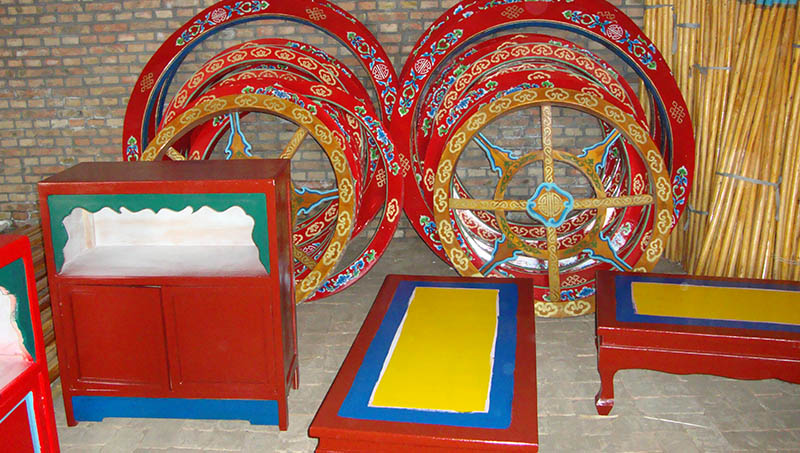Mongolian furniture materials
1. Main materials
The Mongolian people live on the vast grasslands and create their own art forms. Among them, wood craftsmanship is one of the artistic types that can reflect its national characteristics, and it penetrates into people's production and life. The main wood used in Mongolian traditional furniture is the native tree species, such as pine, birch, willow, and poplar. A long time ago, the ancestors of the Mongolian nationality had recognized the characteristics and uses of these trees, and accurately applied them to different types of furniture. For example, pine wood has strong cold resistance, good uprightness, and hard material. It is generally used to make tables, boxes, cabinets and other larger furniture; while poplar is soft and easy to deform, it is generally used to make food boxes and decorative boxes. What a small house.
2. Decorative materials
The characteristics of the trees growing in the northern alpine zone directly affect the decoration craftsmanship of Mongolian traditional furniture. The surface is often pasted, lined with ash, etc., which creates the typical decorative features of Mongolian traditional furniture with thick paint and color. The coordinated collocation of furniture paints can truly reflect the traditional customs and aesthetic orientation of the Mongolian people. Famous craftsmen are good at using various minerals in nature to make paints and lacquer decorations on the surface of furniture, and use them together with rock goat blood, velvet antler, goat brain and marrow, milk, camel milk, yogurt pulp, etc. as top ingredients. These ingredients can not only cover the rough wooden surface of the furniture to prevent abrasion, but also have the function of preventing deformation due to moisture. The cortical effect on the surface of some furniture is the result of oxidation by adding animal blood to the paint paint. This unique traditional ingredient makes the decorative patterns on the surface of the furniture more three-dimensional, and also makes the whole piece of furniture have a sense of history. In addition, the surface decoration of some small furniture is mostly carved and inlaid with animal bones.
It can be seen that the materials of Mongolian traditional furniture are mostly cheap natural objects that are quickly picked up on the grassland. "Applying arts in accordance with their aptitude" can be regarded as one of the characteristics of Mongolian folk traditional crafts. The identification, use and decoration of these materials not only fully reflect the natural characteristics of the materials, but also reflect the innocent and simple aesthetic consciousness of the Mongolian people, but also penetrate a nomadic culture of ecological beauty and harmony between man and nature. The cultural essence of coexistence.
2. Furniture shape
Form, that is, the ancient expression of modeling style, also called "tool shape". As far as the shape of Mongolian traditional furniture is concerned, it is the so-called "according to the direction of the system, and each has its own suitability." Among them, "suitability" is mainly manifested in two aspects: the shape and composition of the furniture.
1. The form of furniture
Due to the influence of the nomadic lifestyle, Mongolian traditional furniture is mainly used for storing items and storing items. The dome shape of the yurt, the special transportation methods such as the lele cart, and the living and living methods that are convenient for people to burn the fire, all limit the volume of the Mongolian furniture-mostly low-rise furniture, with a square, simple and clumsy shape. The outline is stretched and concise, giving people a dignified and practical psychological feeling, which reflects the rough and unrestrained aesthetic consciousness of the Mongolian people and the simple and elegant customs and culture. However, while pursuing the beauty of masculine appearance, traditional Mongolian furniture also has delicate aesthetic connotations. In the details of the furniture shape, the colorful and ever-changing stitches are appropriately applied to the main shape of the furniture, such as the legs, feet, side wipes, and tooth boards. Among them, in the cabinet furniture, there is a longitudinal thread component that is a cloud-shaped tooth board slightly shorter than the cabinet height, which also plays a role of reinforcement and decoration. This special furniture component can be regarded as one of the characteristics of Mongolian traditional furniture, reflecting the modeling principle of close integration of aesthetics and practicality that Mongolian traditional folk art has always followed.

2. The composition of the furniture
The Mongolian traditional furniture is mostly cabinet furniture, which emphasizes symmetry, balance, fullness and complexity in composition. In order to facilitate the classification and placement of items, people regularly divide the facade space of furniture into several independent rectangular areas, thus forming a geometrically stylized furniture composition form, which reflects the independent integrity of the furniture composition. Among them, each part of the furniture is based on a carpet-like decorative composition method, using suitable patterns, border patterns, corner patterns, etc. to combine with each other to form a relatively independent partial composition, avoiding the rigid and rigid composition of the furniture as a whole. Whether it is the overall composition of the geometrically stylized furniture or the carpet-like partial decoration composition, it gives people a sense of stability and unity. This contrasts with the fluidity of Mongolian nomads, reflecting the living under the vast grassland and quiet sky from the side. The peace and tranquility possessed by the Mongolian people.


 Recommended
Recommended


